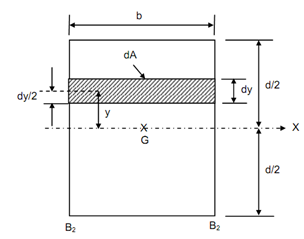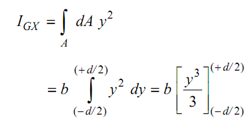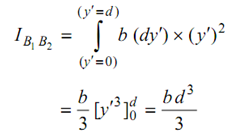Find out the axial moment of inertia:
Find out the axial moment of inertia of a rectangular area of base b and height d around centroidal axis GX and the base B1B2.
Solution
With Reference to Figure, where centroidal axis GX divides the area at mid-depth, i.e. d/2.

Figure
For a thin strip, illustrated shaded, of width b and thickness (very small) dy, all of the points on it are at a constant distance y from axis GX,
∴ dA = bdy
Letting y as positively upward from centroidal axis GX: for elements below
GX, y shall be treated as negative.
∴ ∫ A dy = 0

=bd3 /12
Likewise, referring to y axis through centroid G,
IGY = db3 /12
Moment of inertia around base B1 B2 may be computed either directly or by utilizing parallel axis theorem.
Direct approach is as. Referring to Figure,
I B1 B2 = ∫ dA × ( y′)2

On the other hand, using theorem of parallel axis, we have
I B1 B2 = IGX + A ( y1 )2
Where y1 = d/2 = perpendicular distance between GX and B1B2.
= b d 3/12 + b d (d/2)2 ?
= b d 3/ 3